#ancient seafaring
Explore tagged Tumblr posts
Text
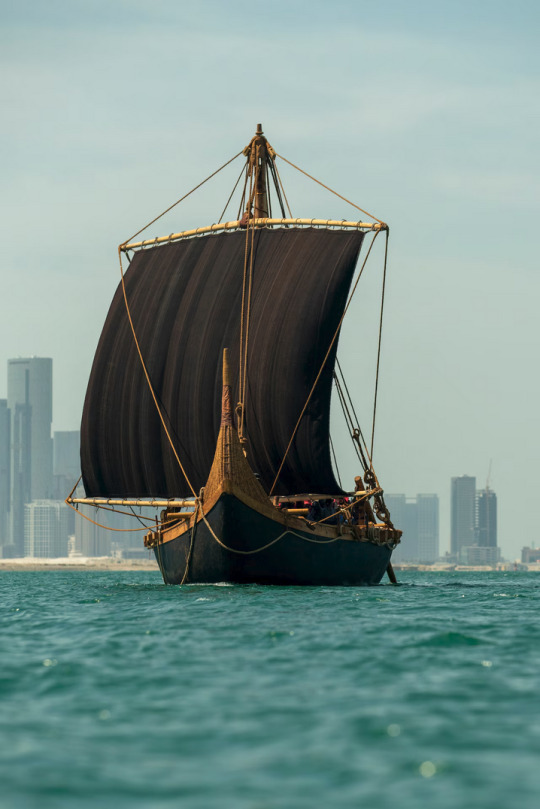
For the first time in millennia, a Magan Boat sails off the coast of Abu Dhabi. It’s a reconstruction that has taught the world much about the skill and achievements of Bronze Age sailors
Archaeology on Marawah Island, west of Abu Dhabi, has revealed that 8,000 years ago the Arabian coast was home to a sophisticated seafaring people. They built stone structures, herded livestock, fished and dived for pearls, crafted jewelry, and developed a talent for sailing that started a remarkable cultural exchange.
By the Bronze Age, around 4,500 years ago, the region was prominent enough to have a name in ancient writings: Magan. From the island of Umm an-Nar, in modern Abu Dhabi which was part of ancient Magan, merchants sailed an international trade route that connected Mesopotamia, in what is now Iraq, to the Indus Valley in today’s India and Pakistan. Magan traded locally sourced pearls, stone and copper, one of the most sought-after commodities of the time, for ceramics, fabrics, jewelry, and other precious objects. Its ships were renowned through the Arabian Gulf.
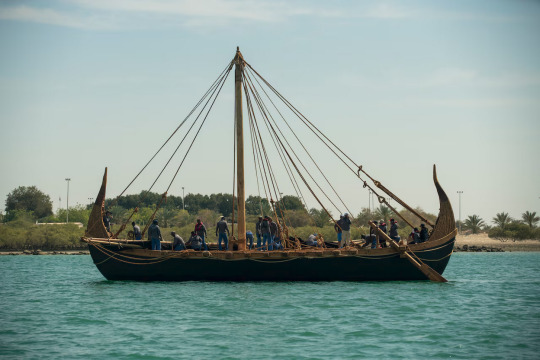
The ship was built using 15 tons of locally sourced reeds that were painstakingly prepared by being soaked, stripped of leaves, crushed, and then tied into bundles using rope made from date palm fibers. These formed the hull, to which was attached a wooden frame. The boat’s dimensions were calculated based on what is known about similar vessels as well as hydrostatic analysis of what was needed to make it float. The reed hull was then waterproofed with a coating of bitumen, which was traded from Iraq. The heavy sail, raised purely by muscle without the benefit of pulleys, was crafted of goat’s hair in a patchwork of shades.
The result was the world’s largest ever reconstructed Bronze Age vessel: 60 feet long, capable of carrying 36 tons of cargo, and achieving surprisingly high speeds of 5.6 knots.
#naval history#naval artifacts#archaeology#magan boat#around 2350 BC#bronze age#replica#ancient seafaring
3K notes
·
View notes
Text
Ancient Seafaring
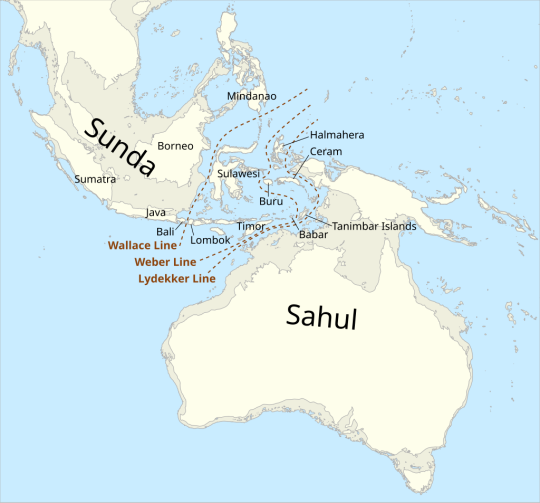
By listfiles/Kanguole - Own work, based on file:map of Sunda and Sahul.png and usingCoastline from Natural Earth 1:50m Physical Vectors125m depth contour derived from 2-Minute Gridded Global Relief Data (ETOPO2) v2, NOAA National Centers for Environmental Information, using gdal_contour (from GDAL)., CC BY-SA 4.0, https://commons.wikimedia.org/w/index.php?curid=127823375
Earliest evidence that hominids took to the sea on boats was from tools and trace evidence left on a rhinoceros skeleton from about 631,000-777,000 years ago, likely to the Philippine island of Luzon, the largest island of the Philippines. At this time, Homo erectus was most likely the voyager. At that time, with the lowered sea levels because of the ice sheets that pushed as far as the 40th parallel in some places, covering maybe 30%, drawing water out of the oceans. While this made it so that many of the islands off of the southern tip of India were joined together, reaching the Philippines would have taken at least a short sea voyage.
It wasn't until about 65,000-53,000 years ago that Homo sapiens crossed what is now known as the Wallace line to reach what is now Australia. The winds at the time would have been favorable for what would have been at least a 55 mile (88 km) journey with no land in sight. Winds would have changed about 58,000 years ago, making the crossing much more unlikely, which points to a single period of colonization of Australia.
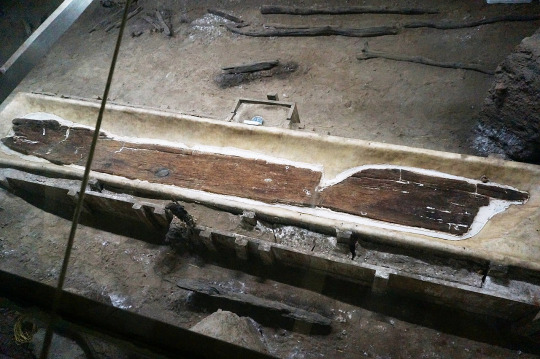
By Cat's diary (猫猫的日记本) - Own work, CC BY-SA 4.0, https://commons.wikimedia.org/w/index.php?curid=34243737
About 35,000-32,000 years ago was the beginning of maritime trade networks as evidenced by Philippine and Wallacea obsidian appearing one nearby islands, though exactly how people traveled by sea isn't know, whether by rafts or dugout canoes. These trade routes likely began by following the coastlines and moving by between line-of-sight islands.
The earliest evidence of whaling appears around 6000 BCE in Korea. Most likely, the method involved many small boats to cut the whale off from the ocean and herding it to land with noise and perhaps arrows.
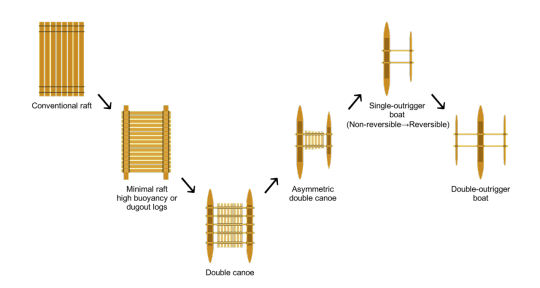
By Obsidian Soul - Own work, CC0, https://commons.wikimedia.org/w/index.php?curid=75764398
Between about 3000 and 1500 BCE, with the use of catamarans, outrigger ships, and tanja or crab claw sails, the Austronesian people began leaving Taiwan and colonizing islands as far reaching as Easter Island and New Zealand to the east and Madagascar in the west. They also supported a trade network that was the precursor of the Maritime Silk Road, which began in the 2nd century BCE. These trade routes gradually began using the monsoon winds, which would blow in one direction for half the year and switch directions in the other half, making it possible for bulk trading and for the Maritime Silk Road to develop. Maritime trade routes grew safer than overland routes due to a lack of bandits, improved navigation technologies, and lack of 'extortionate tolls by local potentiates.'
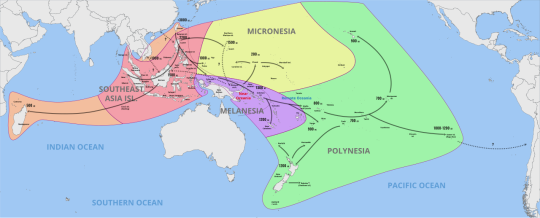
By Pavljenko - Own work using:Map first shown in Bellwood et al. (2011) and taken from Benton et al. (2012), CC BY-SA 4.0, https://commons.wikimedia.org/w/index.php?curid=116424449
Evidence of the spread of Austronesian people is evident in the languages spoken on the many islands they reached. There are many words that are derived from Sri Lankan or south Indian languages, such as the various words for 'ship' including paṭavu, paḍava, padau, folau, halau, and wharau. Austronesian peoples used advanced navigation techniques, using both constellations and the timing of stars rising over the horizon to navigate. There also appears to have been a 2,000 year pause in expansion, to about 700 CE, when the Polynesian people group moved into the Cook Islands, Hawaii, Easter Island, and Aotearoa, New Zealand.
The Chinese began trading with the Austronesian peoples during the Han dynasty (220 BCE-200 CE), calling them 'Strange Things of the South' (Nánzhōu Yìwùzhì — 南州異物志). Despite this, or maybe because of it, they didn't develop their own navy until the Song Dynasty (960-1279 CE).
#seafaring#indian ocean seafaring#ancient seafaring#maritime silk road#human development#human history
3 notes
·
View notes
Text
youtube
The Ancient Navigators of the Ocean
Discover the incredible world of sea turtles! From their epic migrations to unique adaptations, these ancient mariners are a marvel of nature.
Check out my other videos here: Animal Kingdom Animal Facts Animal Education
#Helpful Tips#Wild Wow Facts#Ancient Navigation#Ocean Explorers#Maritime History#Ancient Mariners#Oceanic Expeditions#Nautical Traditions#Early Seafarers#Ancient Sea Routes#Ocean Exploration#Ancient Sailors#Historical Navigation#Seafaring Cultures#Ancient Ships#Ocean Mapping#Maritime Exploration#Nautical Legends#Oceanic Discoveries#Ancient World Exploration#Navigation Techniques#Maritime Legends#Oceanic Cultures#Ancient Maritime Trade#Early Navigation Tools#Ancient Seafaring#Maritime Archaeology#youtube#animal kingdom#animal science
1 note
·
View note
Text
While I don't think the King and Siffrin are at all related, I do think there's symbolically a lot to be said about him siding with the party against the King as choosing love over family.
Or family (chosen) over family (blood), as the case may be.
This is especially fun if you want to go with ancient Greece as your inspiration for the culture of the Northern Island (because lots of star myths and being the origin of the whole Sisyphus legend), since kinslaying was an absolute hard no in that culture.
Like, generally most societies aren't cool with people killing their family members, sure, that's typically frowned upon. But the ancient Greeks were really serious about it even by your usual standards- it doesn't matter what your relatives did, you need to get someone they can't point to on a family tree to off them or you're in deep shit.
Siffrin and the King are (probably) not blood relatives unless you have a particular headcanon about that- I personally don't- but they are both Northern Islanders, in a world where that's becoming tragically, increasingly rare.
There's so few of them even left- and by choosing to walk into that throne room and confront him with the party, Siffrin ensures that, however this ends, by the time it's over there's going to be one less.
And that, no matter how much they hate each other, is a fundamental tragedy. They aren't family, but in a very real sense, Siffrin choosing to kill him is kinslaying, and I think they both know that.
I wonder if that adds to Siffrin's feelings that he has nowhere to go once their journey is done? Not only is his homeland gone, he's actively turning his back on the person who most openly represents it.
Of course, the King was the one who decided to put lethal force on the table here first by launching his whole supervillain plan to begin with, so he doesn't exactly have the moral high ground, here.
Personally, I'd love to see the two of them have an exchange a la the end of Euripides' Medea, where Jason declares that the Furies will bring vengeance on Medea for her crime of spilling family blood, and she's just like 'lol you think the gods are gonna listen to you after the shit you pulled?' The Universe ain't gonna do shit for you, tin can! You're not the favorite anymore!
(Actually, Siffrin as Medea is a fun thought in general, given the whole "almost broke the world for love" angle. Thankfully, he's lucky enough to have better taste in love than she did- inasmuch as she got a choice in the matter. Add in the parallels of 'came here from a foreign land, strange and dangerous powers, totally down for regicide'... yeah, I think you could do something with that.)
#ISAT#ISAT spoilers#personally I like to mix and match for my Northern Island headcanons#do a combo of the game dev's own idea of Guadeloupe with some ancient Greek so you end up with something more unique#although funnily enough when I first heard about the Northern Island my immediate instinct was 'oh well obviously they're Polynesian'#because damn those guys have their astronomy on LOCK#I like how there's a lot of room to find a counterpart culture and so many options#but they all still had the common thread of 'seafaring island-based nations with a rich cultural tradition around the stars'#...I guess if Loop doesn't vanish for good afterwards the amount of Northern Islanders in the world technically hasn't changed#net zero difference via the Siffrin duplication glitch!
30 notes
·
View notes
Text
Viking Ice Skates

In a discovery that harkens back to the days of Nordic exploration and seafaring prowess, Viking Ice Skates from the 10th century CE emerge as a testament to the adaptability and ingenuity of these legendary mariners.
Crafted from leather and horse bone, these relics offer a fascinating window into a world where icy landscapes presented both challenge and opportunity.
As the Viking Age unfurled across the northern seas, the need for swift and efficient movement extended beyond the waves to the frozen landscapes of the North.
The Viking Ice Skates, fashioned with materials readily available to these intrepid seafarers, embody their mastery over both water and ice, underscoring the versatility that defined their pursuits.
The composition of these ancient ice skates sheds light on the resourcefulness that defined Viking craftsmanship.
Leather, pliable and durable, formed the base of the skates, offering comfort and flexibility to those who donned them.
Horse bone, carved into blades, enabled a gliding motion across frozen surfaces, bridging the gap between land and frozen waters.
Beyond their functionality, these ice skates offer a portal into the mundane yet captivating aspects of Viking existence.
As seafarers and traders, Vikings navigated a diverse range of environments. The ice skates underscore the multifaceted nature of their lives, highlighting the interplay between practicality and cultural adaptability.
In a time where technology and travel were vastly different from the present day, the Viking Ice Skates provided a means of efficient movement across frozen landscapes.
The relics, a silent testament to their owners' journeys, stand as a connection to the daily experiences of these seafaring adventurers.
Viking Ice Skates not only speak of practicality but also offer a glimpse into cultural practices.
Skating, beyond its functional purpose, may have held social or recreational value. The skates' existence within Viking society underscores the integration of ice-bound activities into the fabric of their lives.
The discovery of these ice skates resonates with the broader mission of preserving historical artifacts.
As these relics emerge from the depths of time, they remind us of the importance of safeguarding and studying the past to better understand the cultural and technological foundations upon which we stand today.
Viking Ice Skates, though seemingly modest, echo the enduring legacy of a civilization that has captivated modern imagination.
They remind us that the Vikings were not confined to the pages of history but were dynamic individuals who adapted to their surroundings, leaving a mark that endures through the ages.
Viking Ice Skates stand as more than mere relics; they are a testament to the Vikings' mastery over diverse environments and their capacity for innovation.
These ice skates transcend the boundaries of time, allowing us to skate through history and glimpse the daily lives of these legendary seafarers.
As they emerge from the past, they extend an invitation to explore the interplay between necessity, creativity, and cultural evolution that defined the Viking Age.
📍Swedish History Museum, Stockholm
#Viking ice skates#ice skates#viking age#vikings#seafaring adventurers#frozen landscapes#cultural practices#historical artifacts#legendary seafarers#relics#Swedish History Museum#Stockholm#Sweden#ancient civilizations
5 notes
·
View notes
Text




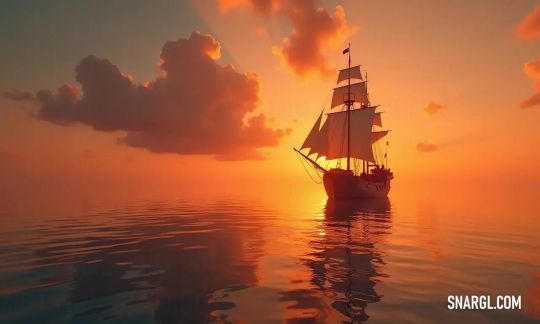
Timeless Sailing Ships - The Vessels of History
Sailing ships that became symbols of great maritime discoveries are truly timeless. Discover fascinating facts about these majestic vessels and their impact on the history of navigation.
#snargl#tall ships#sailing life#maritime history#seafaring#sea adventures#shipwrecks#sailing ships#historic vessels#naval legacy#ancient ships
1 note
·
View note
Text
Me writing yet another history-based fanfiction: yayyyyyy research time!
#this time it's 1890s european culture and seafaring practices and details about russian schooners#not to be confused with my fic about new york in the 1910s. or my fic about ancient egypt among many other historical references#or my character who's lived through 1000 years of history. or my character who's lived through FIFTEEN THOUSAND years of history#(eris and prometheus respectively for those last two. and funny enough despite the names I don't focus THAT much on greek myth w them)#my writing#oc vivienne#heart in your hands fic#who waits forever anyway? fic#oc eris#oc prometheus
2 notes
·
View notes
Note
do you think the music box is a constant throughout each loop? I mean, both Six and Rascal had their own different music boxes independent from each other, so I don’t know. I wonder what the other Ladies’ music boxes sounded like.
I actually think yes. Yes they do have themes. And I hand picked them from the LN ost repertoire myself.
Fox - Beneath the Waves
Tengu and Scarecrow - The Death Waltz
Teapot - Prison Toys
I think narratively all these songs would make logical sense when paired up with the Ladies.
Teapot has a prisoner motif and is known to be curious, so the song having this sense of wonder only to end on a nostalgic piano recreation of the melody makes especially sense when you remember there's a piano in her section. The Death Waltz goes to the sisters for obvious reasons, but I also like how the musical base of the song plays a completely different tune from the singing voice, yet the two don't necessarily make the other less enjoyable. They just go together on parallel lines. As for Fox... Beneath the Waves is perfect because to me it really sounds like someone being lost and not knowing where to go/be, only for the Maw to come in at the very end.
12 notes
·
View notes
Text
Ancient Egyptians and Phoenicians may have Mapped Antarctica.
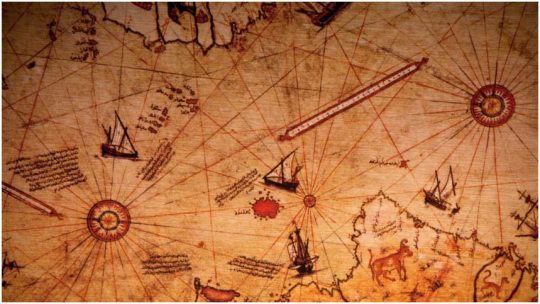
View On WordPress
#Achievements#Ancient inventions#Antaractica#Astronomy#Bible#Cartography#Cultural exchange#Egyptians#Events#Exploration#Great Pyramids#Hebrews#Knowledge#Math#Phoenicians#Seafarers
2 notes
·
View notes
Text
.@PopMech
"#stonetools excavated...in the #Philippines, #Indonesia & #Timor_Leste [show] strong evidence that as far back as 40,000 years ago, there was a technological sophistication from these #ancientseafarers that rivals much later civilizations"
#Mu?
https://www.popularmechanics.com/science/archaeology/a64969231/ancient-boats-found-southeast-asia/
0 notes
Text
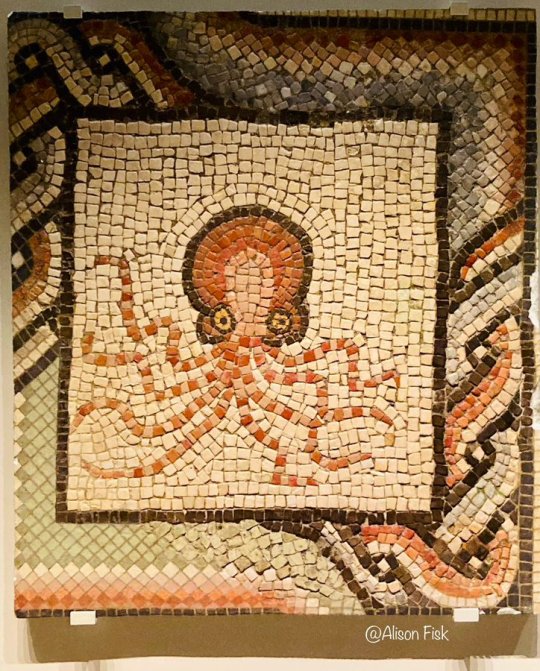
A charming little octopus from a Roman villa at Villaquejida, Spain, 2nd-3rd century AD. Museo Arqueológico Nacional, Madrid. Photo by Alison Fisk
#naval art#naval artifacts#roman mosaic#octopus#2nd - 3rd century ad#ancient seafaring#sea creatures
2K notes
·
View notes
Text
Sea Cryptic! Danny Pt.9
[Pt.1] [Pt.2] [Pt.3] [Pt.4] [Pt.5] [Pt.6] [Pt.7] [Pt.8] [Pt.10]
"Fan-sea meeting you here. You must be Phantom!"
Danny slowly turned around, grin blinding. "I shore am. Who's asking?"
Danny knew exactly who was asking. Bludhaven's vigilante, Nightwing. If the giant dark blue bird emblazoned on the front of his suit didn't give it away, the friendly demeanor and the puns would have. Plus, now that Danny's figured out who Tim was, the rest were pretty simple dots to be connected.
"Hi. I'm Nightwing. Thanks for saving Batman."
"I am Phantom. You are welcome. Please lecture him on the necessity of keeping the waters clean."
"Uh, I think he knows," Nightwing grinned. “So, why are you cleaning Gotham’s bay? I heard the Atlantic is nice this time of year.”
“Exactly. This?” Danny flapped a gloved hand around them, specifically at the moldy docks and the paint scraped board. “This is not nice. If it were nice, I wouldn’t need to be cleaning it. Look at that paint! It’s flaking off into the water! Does Gotham not have proper boat maintainance? That’s dangerous for the waters and seafarers!”
“Woah, you know a lot about boats,” Nightwing commented, crossing his arms and leaning back. What the hero didn’t know was that he knew more about boats than Danny did, as Danny’s hyper fixation was more focused on space ships and Dick had education à la maison de Bruce Wayne which usually meant an absurd amount of information for someone who doesn’t actually use boats as a regular mode of transportation.
“Rust! Rust is very much a thing!” Danny ranted, using his ice to scoop up water and using it like a makeshift filter. “It weakens bonds! It’s a tetanus hazard! And oh, don’t even get me started on how you people mutated the ocean life!”
“Mutated ocean life? I’m pretty sure we hadn’t. It’s just a little weird, right?”
Without another word, Danny dove into the weird ecosystem that was the Gotham bay. He came back holding a wriggling green thing the size of a worm.
“Do you know what this is?” Danny demanded. The thing flopped around on his gloved hands.
“A sea monkey?”
“They’re brine shrimp. Brine. Shrimp. Do you know what regular brine shrimp look like???” Danny shoved the thing at Nightwing, who took a step back.
“Not like that?” He replied, a quizzical look on his face.
“No, not like that! What in the ancients is this?!” Danny waved the weird sea brine that had started glowing faintly, like Danny’s natural ectoplasm glow. “Far be it from me of all people to judge evolution but this was all man made!” Danny gently tossed the brine shrimp back into the bay. “Brine shrimp is staple food for the ocean! You’ve got weird brine shrimp? You’ve got weird fish! Why is it impossible for this place to, for even one day, refrain from dumping hazardous chemicals or dead bodies in the water?”
“Ooookay, how about we take a breather?” Nightwing quickly glanced around, trying to find something to change the subject, feeling oddly guilty at the earnest expression on the kid’s face. “Uh, I was actually wondering if you’d swing by the waters near Blüd?”
Danny crossed his arms. “I clean the waters as a past time because you humans don’t know how to keep it clean. I am not a personal, on call, seakeeper.”
“Batman will pay you for your time,” Dick offered. Danny straightened. Amity didn’t actually cost that much to live well, but Gotham was a whole other ball park. The rent might be dirt cheap for a city, but the special pricey little add ons such as gas masks and space level insulation on top of the sky high insurance policies were draining what’s left of his half dead soul. As they say, Danny was a city dweller first and Phantom second.
“How much, when, and I won’t fish up the bodies unless he pays me extra.”
“Four thousand base pay, extra one hundred per identity, fifty for bodies with no shades, and on the weekends.”
Danny straightened as his mother’s steel spine, Jazz’s whip sharp wit, and his own craftiness made their appearance as he bargained. “Five thousand. Rate agreed, but I can only do every other weekends and I’ll have to call out some days.”
“Okay.” Nightwing rocked back on his heels with an affable smile. It’s Bruce’s money and it’s going towards his probable future baby brother, after all, even if said baby brother is a dead immortal Atlantis founder. Or something.
Danny groaned. “You are supposed to bargain back. But I’ll take it.”
“Great! Who do we got tonight?” Nightwing looked down at the plastic/burlap wrapped person Danny dragged onto the shores a bit ago.
“The lake kept the body cold, so it should be preserved adequately if you want to examine him,” Danny tilted his head to the side, the flames of his hair tilting with him. “He said his name is Gorganzo Bean.”
“Really?”
“Yes. It’s a nickname he got for eating a whole can of beans straight.”
“Yeah, that’ll do it. Any more details?”
“Sure.”
When Danny reached to take the money from Nightwing, he found that the hero had tightened his grip on it.
Danny pointedly dropped his gaze from Nightwing’s face to the money.
“Wait. I- I heard from a source that you could possibly smell souls.”
Danny yanked the cash out of Nightwing’s hand and shoved it into his shoulder. If that didn’t confirm Nightwing’s identity, he doesn’t know what would other than the guy telling Danny who he was. “You’ve been speaking with Danny. Yes, I can.”
“Can you tell what’s wrong with my brother?” Nightwing blurted out.
Danny stared at him, his legs flickering in and out to his tail form. “…Other than dressing in probably leather or Kevlar and going out to beat criminals with his bare hands?”
Nightwing opened and closed his mouth. He coughed awkwardly. “Other than that. Why is he- um, stinky? Soul-wise,” Nightwing added, clearly humoring the tinny little voice at the base of his temples that was an annoyed Red Hood saying that he showered. “He showers often. And is definitely not stinky body odor wise.”
“I am not a doctor. Well, not now anyways,” Danny said, thinking about his future PhD. “But he’s got a… soul infection. His natural immunity- all souls have a natural immunity against regular outside influences- is working hard to repel the equivalence of chronic bronchitis.”
“There’s… no way to help him?”
“I never said that,” Danny tilted his head. “Bring your brother to meet Danny. He could probably handle it.”
“The civilian?”
“His parents hunted my kind, once. He helped protect me and my people. If anyone knows how to cure it, it would be him.”
Phantom could not afford to deal with this right now, because Danny had a presentation tomorrow that he needed to finish.
“Oh. Thank you, Phantom.” Nightwing said, looking relieved and pensive. Danny decided right then and there that was Future Danny’s problem.
Danny nodded distractedly, blinking out.
He blinked back in. Nightwing jerked back. “Do you happen to have any examples of corrupt politicians in Gotham?”
Nightwing blinked before laughing. “It’d probably be easier to name the ones that aren’t.”
“Good to know. Thank you!”
——
A couple of days later, Tim and two older guys ambushed him in the quad.
“Hi! I’m Dick! This is my brother Jason! We’re Tim’s older brothers!”
Danny looked down at his hand- trapped in an overexcited handshake- and back up at Dick.
Whatever expression he was making, it must have been ha-fucking-larious because Tim and Jason burst out into laughter. Danny cursed his past self.
“Yeah?” Danny blinked. Wait. His smile grew and he made a face like he just realized something. “Oh. So you’re Nightwing?”
The laughter cut off.
“Haha, what?”
“Phantom told me you’d be coming but I, uh, thought you’d be in gear. Not… straight up telling me who you are?”
“You’re in regular contact with Phantom?” Tim demanded.
“Yeah, dude. After you- wait, you’re Red Robin!” Danny whispered.
“Oh shit, B’s gonna be pissed,” Jason drawled, looking mildly amused and hiding an extremely cautious, possibly lethal (if it weren’t for the fact that Danny’s pretty much impossible to kill with regular weapons) reaction.
“You’re one to talk. I’d smell your soul no matter what your disguise was.”
“…About that.”
——
You might be wondering: wouldn’t Dick know not to show up in civvies?
Yes. Except for the fact that Tim stalked Danny for weeks after he met Phantom and Danny hadn’t hung out with (himself) at all. They think Danny doesn’t know Phantom well enough to even talk to him much, despite being from the same town because: they’re all big city kids and have never experienced small town solidarity and, more importantly, gossip grapevines + they have no idea these two are the same people.
A deleted scene:
“When did you have time to talk to Phantom?” Tim demanded. Jason nudged Tim. That had hinted too much at what Tim was doing on his off hours and stalking was usually frowned upon.
“When I wasn’t talking to you, duh.”
#danny phantom#batman#dpxdc#dcxdp#Tim Drake#Nightwing#Dick Grayson#Jason Todd#bamf danny#red hood#stinky red hood#danny: oh wow they just handed me the perfect excuse#sea cryptic! danny au
3K notes
·
View notes
Text

The Siren
Artist: John William Waterhouse (English, 1849-1917)
Date: c. 1900
Medium: Oil on canvas
Collection: Private Collection
Description
The painting depicts a siren sitting at the edge of a cliff, lyre in hand, staring down at a shipwrecked sailor floating in water, who in turn is staring up at her.
‘Oh happy seafarers are ye And surely all your ills are past, And toil upon the land and sea, Since ye are brought to us at last; But now, but now, when ye have lain Asleep with us a little while Beneath the washing of the main, How calm shall be your waking smile!’ William Morris, Life and Death of Jason, 1867
In the aftermath of a shipwreck, an exhausted survivor struggles towards the safety of the shore. He clings to an algae-clad rock without the strength to pull himself from the dark waters that surge and ebb around him. The treacherous currents and undertows threaten to pull him under the waves and almost all his strength is gone. At this moment of crisis, he is surprised by the beautiful vision of a young girl sitting on the rock above him with pearly-white skin and with lips parted in song. Her passive expression is enigmatic and whether she will help him or harm him we cannot know but we can be sure that he is spellbound by her pale beauty and magic song. Her abalone-shell harp and pearl hair decoration identify her as one of the sirens – ancient beguiling enchantresses of the ocean who lured mariners to their doom with their seductive song. The lower part of her legs, splashed by the spray of the sea, are magically transformed into the glistening fish scales and fins of a mermaid. Her hair is the auburn hue that in the nineteenth century became a potent symbol of the femme fatale. But she is not the vicious predatory sea-creature painted in continental Europe by the likes of Arnold Bocklin, Franz von Stuck or Gustave Moreau. She appears innocent of the harm her singing has caused and continues to pluck at the strings of her harp and gaze down at the drowning sailor below, as curious of him as he is of her.
#literary art#life and death of jason#book by william morris#literary scene#literary characters#pre raphaelite brotherhood#ocean#mermaid#man#cliffs#lyre#sea shore#pre raphaelite art#art and literature#painting#oil on canvas#fine art#oil painting#artwork#english culture#english art#european art#john william waterhouse#english painter#20th century painting#private collection
363 notes
·
View notes
Text
Ἀπόλλων Φοῖβος, Θεὸς τοῦ Ἡλίου
Apollon, Bright One, God of the Sun
He is associated with Sunlight and the Sun, Music and Poetry, Prophecy and Oracles, Healing and Medicine, Plague and Disease, Archery, Knowledge and Wisdom, Purification and Cleansing, Order and Civilization, Protection of Herds and Flocks, Seafarers, Masculine Beauty, Music Theory and Harmony, Time and Seasons.
His symbols are the Lyre, Bows and Arrows, the Laurel Wreath, Ravens, Serpents, the Sun/Chariot of the Sun, Palm Trees, Bay/Laurel Trees, Wolves, Cypress Trees, Tripod, Lyric Poetry Scrolls, Golden Hair and Swans.
Major Sanctuaries and Temples
Delphi was the most famous sanctuary of Apollon, home to the Oracle of Delphi and the Pythian Games.
Delos was Apollon’s birthplace and celebrated Him with grand festivals like the Delia.
Didyma was known for its oracle and the Temple of Apollon, featuring massive columns.
Claros was another major oracle site, with its temple and priesthood.
Thermopylae was sacred to Apollon during the Amphictyonic League meetings.
Bassae was home to the Temple of Apollon Epikourios, renowned for its architectural innovation.
Aegina featured a Doric temple dedicated to Apollon.
Patara was an ancient Lycian city with ties to Apollon and prophecy.
Miletus’ citizens worshipped Apollon as their protector.
Rhodes revered Apollon as part of the island’s patron deities.
Athens worshipped Apollon in several roles, including Apollo Patroos (Protector of Families).
Sparta honoured Apollon as a god of order and harmony.
In Rome, Imperātor Gāius Iūlius Caesar Augustus constructed the Temple of Apollo Palatinus, aligning Apollo with imperial propaganda.
Mt. Parnassus, near Delphi, was regarded as sacred to Apollon and the Muses.
The island of Crete celebrated Apollon in various cities, such as Gortyna and Dreros.
General Epithets
Apollon (Bright, Radiant), associated with His solar and light-bearing qualities.
Delphinios (Of Delphi), linked to His sanctuary and oracle at Delphi.
Mousagetēs (Leader of Muses), celebrating His patronage of the arts and inspiration.
Loxias (Oblique, Mysterious), reflecting His cryptic oracular messages.
Pythios (Of Pythia), commemorating His victory over Python at Delphi.
Alexikakos (Averter of Evil), worshipped as a protector from harm and calamity.
Medicus (Healer), honouring His medical and healing powers, especially in Roman worship.
Catharsius (Purifier), invoked in cleansing rituals.
Smintheus (Mouse God), protector from plague and agricultural pests.
Lykeios (Wolf God), linked to His protective and wild nature.
Nomios (Pastoral), celebrating His guardianship over herds and flocks.
Karneios (Of Flocks), worshipped in rural Spartan traditions as a regional variation of Nomios.
Helios (Sun God), representing His solar connections in later traditions.
Agyieus (Of the Streets), protector of pathways and travelers.
Delios (Of Delos), celebrating His birthplace.
Didymaeus (Of Didyma), connected to His oracle in Ionia.
Festivals
The Pythian Games were held every four years at Delphi, including musical and athletic competitions in Apollon's honour.
Thargelia was an Athenian festival honoring Apollon and Artemis, featuring purification rituals and offerings of first fruits.
Delia, on Delos, was a festival that included musical contests, dances, and sacrifices sacred to Apollon.
Worship Practices
Sacrifices were often of animals such as bulls and goats, symbolic of his divine strength.
Prophecy played a central role in his worship, with priestesses and the Oracle at Delphi channeling his divine wisdom.
Apollon was invoked in rituals of cleansing and renewal, often symbolized by water.
Roman Veneration
Apollo Medicus was venerated as a god of healing during plagues.
Imperātor Gāius Iūlius Caesar Augustus claimed Apollo as his divine patron, constructing the Temple of Apollo on the Palatine Hill of Rome.
Altars and Sacred Spaces
Altars dedicated to Apollon are typically adorned with symbols like the lyre, laurel leaves, sun motifs and representations of His sacred animals (e.g., swans, wolves, or ravens), often altars placed in sunlit areas to honor His solar aspects.
Altars are frequently decorated with golden or yellow fabrics, sun-shaped decorations, and natural materials like wood or stone are common.
Offerings
Traditional Offerings are laurel leaves, honey, olives, figs, and wine.
Music, poetry, and other creative expressions are also considered as offerings due to Apollon's role as a patron of the arts.
Frankincense and bay laurel oil are burned, while crystals like sunstone and pyrite are used to symbolize His solar and abundant aspects.
Rituals and Practices
Devotees skilled in the arts often recite prayers or compose hymns in His honor, often inspired by ancient texts, while others prefer to stay with the ancient texts themselves. Both choices are equally valid.
Practices like meditating on Apollon's attributes or using divination tools to seek His guidance are common.
The creation of or recitation of music and poetry are also acts of worship. From humming a tune to singing along to your favourite songs, it counts as an offering and is just as valid.
Apollon's teachings on balance and enlightenment inspire personal growth and artistic pursuits, often being blended with the pursuit of philosophical and sometimes even spiritual enlightenment.
Rituals for spiritual or physical healing often invoke Apollon's aid, emphasizing His role as a healer.
Devotees seek His guidance in intellectual and intuitive endeavors, reflecting His association with wisdom and oracles.
Seasonal Celebrations:
Some practitioners observe festivals inspired by ancient traditions, such as the Thargelia or Delia, adapting them to modern contexts. I have yet to find a universally agreed upon date, but April 6th or the Spring Equinox are common due to Apollon's purifying and cleansing epithets, as well as His light and solar epithets.
Personal Notes
Apollon is a deity who only very recently called to me, which is amusing to me since I would have been under His protection. It speaks to me of His integrity that rather than reach out to me then, He has waited nearly seventeen years to do so. I think that perhaps is to do with two things which actually blend hand in hand; the first being that I have a strong suspicion that when He reached out to me, it was not as His Greek self nor even His Roman self; rather, it was as Paean (𐀞𐀊𐀺𐀚, Pajawone) that He reached out.
While I try to keep the history out of the religion in these posts, I feel it is best to explain fully in the case of Hellenic deities whose Mycenaean forms call to me most (of which there is a surprising number). Apollon, as Paean, is chiefly a god of medicine and healing. However, in Troy he was a god of hunting and protection, defending the early Trojans from the beasts of the forest. It is this Trojan Apollon, whom they called Paeiōn (𐀞𐀊𐀩𐀍, Pajerone) that called to me and is still known to this day as Apollon Lykeios. For those wondering why the names changed so much, the evolution from Pajerone to Apollon is due to the language changing and evolving during the Greek Dark Ages; the earliest known midway point is Apeljōn, so the linguistic evolution would be Pajerone -> Apeljōn -> Apollon.
With the mini history lesson out of the way, apologies for boring any of you, now to explain the significance of Pajerone/Apollon Lykeios as main epithet I worship. The Wolf God, Apollon Lykeios, is very different from the other representations of Apollon and is quite, shall we say, wild by comparison. He is still a healer, still knowledgeable in philosophy and music, but He is much more akin to His Sister Artemis and Her preference of the forest and the hunt. He is the Wolf, the hunter who struck down the Python and gained prophetic insight, the friend of Hyperborea whose bow can bring any prey low. To me, as Lykeios, he is still a God of Light, but his light is not simply the gold of the sun. It is the green of the field, the red and pink of blood on his skin. It is the purple of his robe and the blue of his eyes, dancing in the sky as the Aurora Borealis. He is the light that dances with the moon and stars, the Hunter who no prey escapes, the Wanderer who heals all with his herbs.
While far from the first Hellenic deity to call to me, He is perhaps the most important one for bridging the gap between the two main pantheons I worship, an ancient link between the northern hunters and the cradle of the West. It is through this link, through His wandering path from Hellas and Hyperborea all the way to Middungeard and beyond, that I can best reconcile worshipping two pantheons without Syncretism. He is a bridge between worlds, a fierce protector and a noble friend to all.
Orphic Hymn to Apollon
Blest Pæan, come, propitious to my pray'r,
illustrious pow'r, whom Memphian tribes revere,
Slayer of Tityus, and the God of health,
Lycorian Phœbus, fruitful source of wealth.
Spermatic, golden-lyr'd, the field from thee
receives it's constant, rich fertility.
Titanic, Grunian, Smynthian, thee I sing,
Python-destroying, hallow'd,
Delphian king:
Rural, light-bearer, and the Muse's head,
noble and lovely, arm'd with arrows dread:
Far-darting, Bacchian, two-fold, and divine,
pow'r far diffused, and course oblique is thine.
O, Delian king, whose light-producing eye views all within,
and all beneath the sky:
Whose locks are gold, whose oracles are sure,
who, omens good reveal'st, and precepts pure:
Hear me entreating for the human kind, hear,
and be present with benignant mind;
For thou survey'st this boundless æther all,
and ev'ry part of this terrestrial ball
Abundant, blessed; and thy piercing sight,
extends beneath the gloomy, silent night;
Beyond the darkness, starry-ey'd, profound,
the stable roots, deep fix'd by thee are found.
The world's wide bounds, all-flourishing are thine,
thyself all the source and end divine:
'Tis thine all Nature's music to inspire, with various-sounding, harmonising lyre;
Now the last string thou tun'ft to sweet accord,
divinely warbling now the highest chord;
Th' immortal golden lyre, now touch'd by thee,
responsive yields a Dorian melody.
All Nature's tribes to thee their diff'rence owe,
and changing seasons from thy music flow
Hence, mix'd by thee in equal parts, advance
Summer and Winter in alternate dance;
This claims the highest, that the lowest string,
the Dorian measure tunes the lovely spring.
Hence by mankind, Pan-royal, two-horn'd nam'd,
emitting whistling winds thro' Syrinx fam'd;
Since to thy care, the figur'd seal's consign'd,
which stamps the world with forms of ev'ry kind.
Hear me, blest pow'r, and in these rites rejoice,
and save thy mystics with a suppliant voice.










#hellenic deities#hellenic pagan#hellenism#hellenic polytheism#hellenic worship#hellenic gods#helpol#hellenic polythiest#greek gods#greek mythology#apollo
194 notes
·
View notes
Text

A Chi drake carrying a week old chick under his robes. He wears typical robes and headgear that supplement feathers for sun and heat protection, and shoes that protect against hot sands. His legs are almost entirely bare of feathers, a trait common only in the most genetically isolated desert qilik populations of the contemporary.
They are one of the many peoples of the region collectively known as the Deadlands, a massive area of desert stretching beneath the equator and trailing out into grassland and savannah in tropical latitudes of a southern continental mass. In the distant past, this region itself held grassland and open savannah and was predominantly inhabited by humans. It experienced rapid desertification over a couple thousand years due to a changing climate, and now vast swaths of the region are completely uninhabitable to large vertebrates. In the contemporary, the only sophont peoples to permanently dwell within its interior are qilik and some nomadically flying caelin.
The Chi are based around a settlement built upon the remains of an ancient human city and around its lake (once potable, now far too salty to drink or for agricultural uses). This salt lake, while not drinkable, supports the basis of the Chi's survival. They feed primarily on the massive swarms of brine flies that dominate the lakeshores, as well as brine shrimp. Parties of foragers venture beyond their home territory in search of other desert insects and reptiles, and forage the coasts and a few scattered oases. Of particular significance is the seasonal appearance of small, migratory wading birds that stop over at the lake to feed on flies and shrimp. This temporary abundance supplies the majority of their meat intake and is of great cultural significance.
They are in closest contact with the Sisisistse people, a collection of semi-nomadic qilik clans who establish themselves around the region's scattered oases and desert springs. A few Sisisistse clans are allies and trade partners to the Chi, but the majority are hostile due to a long history of territorial conflict and the brutal destruction of one clan by the Chi. The closest desert spring to Chi territory was once home to a Sisisistse clan, who, after trade relations decayed, were driven out by Chi warriors, with many of their number slaughtered. This spring is now a permanently occupied Chi outpost and frequently skirmished over.
They are one of few peoples of the vast Deadlands that have sustained and regular contact with the outside world via a few small coastal ports, where salts and a few rare dyes are traded with seafaring qilik peoples from outside the deserts (primarily for textiles- native textile sources are scarce).
Somewhat rarely among qilik people, the Chi place limited significance on gender roles, with drakes, hens, and faeder all performing most of the same tasks and living fully co-mingled lives. The sexual dimorphism of this population is substantially less dramatic than most qilik, to the point that they are imagined as a race of androgynes by many foreigners. Most individuals have bright red-orange plumage (derived from brine shrimp), which drakes emphasize via contrast with predominantly monochromatic garb. Drakes are still tasked with the majority of childrearing (as is nearly ubiquitous among qilik.)
639 notes
·
View notes
Text
The Ancient Greek word for ship was ναῦς. The word is borderline obsolete in Modern Greek, except the majority of seafaring terms actually derive from it.
For example,
ναύτης (náftis) = sailor
ναυτικό (naftikó) = navy <- that’s where the English word originates too
ναυπηγείο (nafpiyío) = shipyard
ναύλα (návla) = ticket for a mode of transportation, especially ships
The common Modern Greek terms for ship are πλοίο (plío) and καράβι (karávi).
Πλοίο comes from the verb πλέω (pléo) which means “float and sail” and it is also etymologically Greek.
I mostly make this post for καράβι which I was convinced to this day that it was a loanword, perhaps from Turkish or Latin.
Today I learned that καράβι too is etymologically Greek, from Koine Greek καράβιον (karávion), from Ancient Greek κάραβος (kárabhos) which meant “prawn”.
A little stupid of me because even the modern Greek word for prawn is καραβίς (karavís) or more commonly now καραβίδα (karavíða) but somehow I never made the connection.
So once again Greeks had the exact word for ship but at some point in time they went nah fook that from now on we gonna call ships
✨Prawn-ions✨
#greece#Greek#Greek language#languages#language stuff#linguistics#langblr#modern Greek#Ancient Greek#funny#Greek culture
336 notes
·
View notes